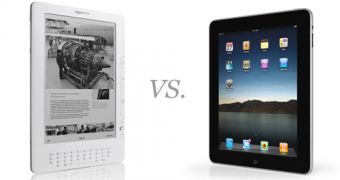Yesterday, we posted a news feature referring to the ChangeWave survey on the report of the e-reader market and its main players, which you can check here. In contrast with the ChanceWave’s survey results, Freescale Semiconductor says Amazon’s Kindle and Apple’s iPad don’t share exactly the same marketplace.
The e-reader market will continue to grow and the iPad won’t cannibalize the other e-readers’ sales. Andrew Nusca has posted on his blog the main scores from an interview on this subject with a Freescale Semiconductor representative.
The iPad is a multitasking device that comprises e-reading, among its parameters, though it was designed especially for web browsing, emails and media playback. In the meanwhile, e-readers, in general, address a customer market different from that of the iPad. Whereas the iPad addresses young web users – students – that usually spend about 35 hours online per day and 30 minutes throughout a day on their phone, the average e-reader customer is an older person.
For such a person, comfortable reading represents the main leisure activity even before TV or the Internet. So, mainly, e-readers have their own loyal consumers and both devices can exist without “killing” each other. This seems to be the argument for which Glen Burchers, consumer marketing director at Freescale Semiconductor, is pleading in the interview posted on ZDnet.
The e-reader’s main inhibitor seems to be the price, with a breaking point of $99. It is very difficult to achieve market growth with a single price decrease, the interview reveals. So, the suggested idea would be to make two steps instead of a single one in order to encourage the market to grow exponentially.
Another important feature is how fast these gadgets are, and if they can get any faster. Nowadays, all e-readers use ARM 11, according to the report. The new generation is aiming for a double speed with the Cortex A8 processors. The main benefit sought here is the screen’s refresh rate. The Kindle takes two seconds to refresh and the Nook take three. They‘re aiming for 0.5 seconds, the physical limit of e-ink technology. Current-generation e-readers don’t employ chips built especially for them, whereas the Apple iPad is known to have its own in-house-built, A4 chip.

 14 DAY TRIAL //
14 DAY TRIAL //